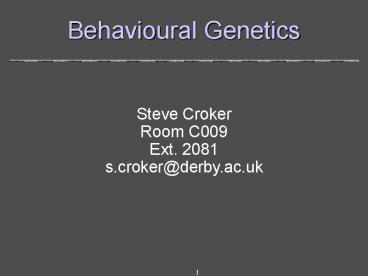Behavioural Genetics PowerPoint PPT Presentation
1 / 20
Title: Behavioural Genetics
1
Behavioural Genetics
Steve Croker Room C009 Ext. 2081 s.croker_at_derby.ac
.uk
2
Outline
- What is behavioural genetics?
- Sources of variance
- Common designs
- Specific developmental psychology questions
- Genes and change
- Does heredity change over time?
- What initiates development?
- Genotype and Environment
3
What is behavioural genetics? (1)
- How can Differences among people be explained?
- Do people differ from each other because of
- Environmental differences -
- they were raised in different families?
- they made different unique experiences?
- Genetic differences
- they are genetically unique?
4
What is behavioural genetics? (2)
- Role for
- Environment
- Heredity
- proportion of the total variance that can be
explained by genetic variance - 2 questions
- How much does each factor contribute?
- How does the 2 factors work together?
5
Designs (1)
- MZ raised apart
- Genetic identical
- Separated, raised apart
- Compare personality characteristics
- Similarities can only be due to genetic
similarities - MZ - DZ comparison
- MZ and DZ raised together
- Share environment, family, parental style
- But 1 huge difference
- MZ genetically identical
- DZ share 50 of their genes (all siblings)
- Compare personality characteristics
- Greater MZ similarities must be due to greater
genetic similarities
6
Designs (2)
- Adoption
- Genetic unrelated siblings in a family
- Share environment, family, parental style
- Compare personality characteristics
- Similarities can only be due to shared
environment
7
Correlation on intelligence test scores (adapted
from Dworetzky, 1996 Bouchard McGee, 1981)
8
How much does each factor contribute?
- Heritability estimates
- Kinship studies
- Texas adoption project (Horn, 1983)
- Minnesota twin study (Bouchard et al, 1990)
- MZ heritability correlation .78
- Pedeson et al (1992)
- MZ heritability correlation .78
- Concordance rates
9
An example Intelligence
- Texas Adoption Project
- correlation with biological mother .28
- correlation with adoptive mother .15
- Scarr (1997)
- 13,000 twin pairs. Intelligence correlation .86
for MZ, .55 for DZ .
10
Problems with heritability and concordance (1)
- Heritability estimates may be higher in
population with shared environment. - MZ twins raised together show more highly
correlated intelligence scores than those raised
apart. - So need to conduct research with twins raised
apart so as not to overestimate heritability - hard to find.
11
Problems with heritability and concordance (2)
- Do twins represent the range of environmental
differences in population even if raised
separately? - More likely to be placed in good homes by
social services. - Heritability estimates have been used to suggest
ethnic differences in intelligence due to
genetics - there are also economic and cultural differences.
- Are these measures useful?
- How do traits develop?
- How can we influence their development?
12
How do heredity and environment work together?
- Reaction range (Gottesman, 1963)
- Canalization (Waddington, 1957, 1966).
- Genetic-environmental correlation (Plomin et al,
1994).
13
Reaction range (from Berk, 2000)
14
Genes and Change
- Genome cant change, but gene activity can
- Gene activity can switch on and off
- Genes are only relevant at certain times
- language effecting genes only relevant from 2nd
year on - Genetic influences can be age-specific
- Genetic influences can be changed
- e.g. Phenylketonuria PKU
15
Heredity Development
- Some studies with kids show influence of the
shared environment - Most studies with adolescents and adults dont
- Siblings growing up and growing apart
- time
- Heredity increases over time
- Influence of shared environment decreases
16
Development of heritability and environment (from
Plomin et al, 2001)
17
What initiates Development?
- Genes play a role in initiating change
- e.g. Puberty is not an environmentally influenced
change - Longitudinal studies of individual development
- Study development of MZ and DZ twin pairs
- Observe synchronicity and compare MZ-DZ pairs
- MZ more synchronic than DZ
- genetic influenced pattern
18
Genotype and Environment
- Gene-Environment correlation
- Plomin et al. (1977, 1994) identified 3 types
- Passive
- Kids receive genotype and family environment
- Evocative
- People react to individuals specifically
- Active
- Individuals seek or create environments
19
Passive, evocatice and active correlation (from
Shaffer, 2002)
20
Learning Objectives
- You should be able to
- Identify the rationale of behavioural genetics
- Correctly describe common designs
- Summarise behaviour genetic research results
- Present specific developmental psychology
questions

